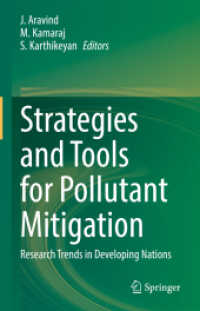- ホーム
- > 洋書
- > ドイツ書
- > Mathematics, Sciences & Technology
- > Chemistry
Full Description
A timely and current discussion of instrumental techniques in atmospheric sciences
In Spectroscopic and Microscopic Techniques in Atmospheric Sciences, a team of distinguished researchers delivers an authoritative and up-to-date discussion of the latest developments in sophisticated analytical techniques and their applications in atmospheric sciences, including chemical identification and characterization, determination of reaction mechanisms and kinetics, and qualitative and quantitative analysis.
Each chapter presents the development of a different analytical method from first principles and highlights the major developments in the technique to date. The book also covers the weaknesses and strengths of each technique and the suitability of its applications in indicated environmental media.
Readers will also find:
A thorough introduction to relevant atmospheric processes
Comprehensive explorations of mass spectrometry and optical, electron, and atomic force microscopy
Practical discussions of fluorescence spectroscopy and ultraviolet-visible absorption spectroscopy
Complete treatments of infrared spectroscopy and Raman spectroscopy
Perfect for graduate students undertaking courses in atmospheric sciences, Spectroscopic and Microscopic Techniques in Atmospheric Sciences will also benefit environmental chemists, climatologists, and analytical chemists.
Contents
Foreword xiii
Preface xv
1 Infrared Spectroscopy and Its Application in Atmospheric Research 1
1.1 Basic Theories 1
1.1.1 Energy Level 3
1.1.2 Vibrational Mode 5
1.2 Infrared Spectroscopic Techniques and Principles 7
1.2.1 Interaction Between a Molecule and an Electromagnetic Field in Infrared Spectroscopy 7
1.2.2 Infrared Spectra 9
1.2.3 Intensities in Infrared Spectra 10
1.2.4 Infrared Reflectance Spectroscopy 10
1.2.5 Specular Reflection (Smooth Surfaces) 11
1.2.6 Diffuse Reflection (Rough Surfaces) 12
1.2.7 Attenuated Total Reflection Fourier Transform Infrared Spectroscopy 12
1.2.8 Fourier Transform Infrared Spectroscopy 13
1.2.9 Sample Preparation Requirements of ATR-FTIR 16
1.2.10 Characteristics of ATR-FTIR 16
1.3 Experimental Facility 17
1.3.1 Structural Overview of an Infrared Spectrometer 18
1.3.1.1 Dispersive Infrared Spectrometer 18
1.3.1.2 Interferometric Infrared Spectrometer 19
1.3.1.3 Light Source 19
1.3.1.4 Monochromator 22
1.3.1.5 Interferometer 22
1.3.1.6 Detector 22
1.3.2 Sample Preparation Techniques in Infrared Spectroscopy 24
1.3.2.1 Gas Sample 24
1.3.2.2 Liquid Sample 24
1.3.2.3 Solid Sample 26
1.3.3 Maintenance of an Infrared Spectrometer 27
1.4 Applications of Infrared Spectroscopy in Atmospheric Research 28
1.4.1 Qualitative and Quantitative Analysis 28
1.4.1.1 Verification of Known Substances 28
1.4.1.2 Infrared Spectroscopic Analysis of Unknown Substances 29
1.4.2 Application in Atmospheric Processes 30
1.4.3 Application in Extractive Measurements 31
1.4.4 Open-Path Fourier Transform Infrared (OP-FTIR) Spectroscopy Measurement Method 32
1.4.5 Application in Interface Characterization 33
1.4.6 Application in Reaction Kinetics 34
1.4.7 Application in Environmental Analysis and Testing 36
1.4.7.1 Chemical Identification of Microplastics 36
1.5 Summary 37
2 Raman Spectroscopy and Its Application in Atmospheric Research 41
2.1 Basic Theories and Principles 42
2.1.1 Basic Theory of Light Scattering 42
2.1.2 Scattering Experiment 43
2.2 Main Types of Raman Spectroscopic Techniques 43
2.2.1 Interaction Between a Molecule and an Electromagnetic Field in Raman Spectroscopy 45
2.2.2 Raman Spectra 46
2.2.3 Intensities in Raman Spectra 51
2.2.4 Influence of Molecular Orientation and Symmetry in Raman Spectroscopy 52
2.2.5 Surface-Enhanced Raman Spectroscopy 54
2.2.6 Tip-Enhanced Raman Spectroscopy 55
2.2.7 Nonlinear Raman Spectroscopy 56
2.2.8 Stimulated Raman Scattering 57
2.2.9 The Hyper-Raman Effect 58
2.2.10 Stimulated Raman Gain and Anti-Raman Scattering 58
2.2.11 Coherent Anti-Stokes Raman Spectrum and Coherent Stokes Raman Spectrum 58
2.2.12 Comparison Between Raman Spectra and Infrared Spectra 59
2.3 Experimental Facility 60
2.3.1 Structural Overview and Basic Components of a Raman Spectrometer 60
2.3.1.1 Excitation Light Source 60
2.3.1.2 External Optical Path System 62
2.3.1.3 Monochromator, Rayleigh Scattering Optical Filter, and Michelson Interferometer 62
2.3.1.4 Detection and Recording System 63
2.3.2 Dispersive Spectrometers 66
2.3.3 Triple Subtractive Instrument 67
2.3.4 Rayleigh Line Filters 68
2.4 Applications of Raman Spectroscopy in Atmospheric Research 70
2.4.1 Qualitative and Quantitative Analysis 70
2.4.2 Application in Gas Detection 71
2.4.3 Application in the Detection of Pollutants and Microplastics 72
2.4.4 Application in the Detection of Nanoparticles 75
2.5 Summary 76
3 Ultraviolet-Visible Absorption Spectroscopy and Its Application in Atmospheric Research 79
3.1 Overview 79
3.1.1 Classification by UV-vis Spectrophotometry 80
3.1.2 Selective Absorption of Light 80
3.2 Basic Principle of UV-vis Absorption Spectroscopy 81
3.2.1 Generation Mechanism of UV-vis Absorption Spectrum 81
3.2.2 Absorption Law and Factors Affecting the UV-vis Absorption Spectrum 82
3.2.2.1 Lambert Law 83
3.2.2.2 Beer Law 83
3.2.2.3 Beer--Lambert Law 83
3.2.2.4 Additivity of Absorbance 84
3.2.2.5 Deviation and Correction of the Beer--Lambert Law 84
3.2.2.6 Deviation Caused by the Non-monochromaticity of the Incident Light 84
3.2.2.7 Deviation Caused by the Solution Concentration 86
3.2.2.8 Deviation Caused by Chemical Factors 86
3.2.2.9 Chromophore and Auxochrome 87
3.2.2.10 Conjugation Effect 89
3.2.2.11 Solvent Effect 90
3.2.2.12 Stereoscopic Effect 91
3.2.2.13 pH Effect 92
3.3 Classification of UV-vis Spectrophotometers and Experimental Facility 92
3.3.1 Components of a UV-vis Spectrophotometer 92
3.3.1.1 Light Source 92
3.3.1.2 Monochromator 93
3.3.1.3 Absorption Cell 94
3.3.1.4 Detector 94
3.3.1.5 Record Display System 95
3.3.2 Classification of Spectrophotometers 95
3.3.2.1 Single-Beam UV-vis Spectrophotometer 96
3.3.2.2 Photodiode Array Spectrophotometer 96
3.3.2.3 Double-Beam UV-vis Spectrophotometer 97
3.3.2.4 Dual-Wavelength UV-vis Spectrophotometer 98
3.3.3 Quantitative Analysis with UV-vis Spectroscopy 99
3.3.3.1 Standard Curve Method 99
3.3.3.2 Standard Addition Method 99
3.3.3.3 Differential Spectrophotometry 99
3.3.3.4 Quantification of Multicomponent Systems 100
3.3.3.5 Multiplication Subtraction Method 100
3.3.3.6 Photometric Titration 101
3.3.3.7 Derivative Spectrophotometry 101
3.4 Applications of UV-vis Absorption Spectroscopy in Atmospheric Research 102
3.4.1 Application in Chemical Oxygen Demand Monitoring 102
3.4.2 Application in the Determination of Heavy Metals in Water 104
3.4.3 Application in the Determination of Nitrate Nitrogen in Water 104
3.4.4 Application in the Characterization of Atmospheric Brown Carbon 104
3.4.5 Application in the Analysis of Dissolved Organic Carbon 105
3.5 Summary 106
4 Fluorescence Spectroscopy and Its Application in Atmospheric Research 111
4.1 Overview 111
4.2 Basic Principle of Molecular Fluorescence 112
4.2.1 Generation of Molecular Fluorescence 112
4.2.2 Fluorescence Spectrum 115
4.2.2.1 Fluorescence Excitation Spectrum 115
4.2.2.2 Fluorescence Emission Spectrum 115
4.2.2.3 Synchronous Fluorescence Spectrum 115
4.2.2.4 Three-Dimensional Fluorescence Spectrum 117
4.2.2.5 Single-Molecule Fluorescence Spectrum 117
4.2.2.6 Characteristics of Fluorescence Emission Spectrum 117
4.2.3 Fluorescence Parameters and Factors Affecting the Fluorescence Intensity 119
4.2.3.1 Fluorescence Parameters 119
4.2.3.2 Factors Affecting Fluorescence Intensity 120
4.2.4 EEM Deconvolution 122
4.3 Experimental Facility 123
4.3.1 Components of a Fluorescence Spectrophotometer 124
4.3.2 Ideal Fluorescence Spectrophotometer 126
4.4 Application of Fluorescence Spectroscopy in Atmospheric Research 127
4.4.1 Application in Quantitative Analysis 127
4.4.2 Application in the Analysis of Single-Component and Multicomponent Systems 128
4.4.3 Application in the Analysis of Aqueous-Phase Processes 129
4.4.4 Application in the Characterization of Continental Aerosol 134
4.4.5 Application in the Analysis of Matter Transfer in Marine Aerosol 136
4.4.6 Application in the Detection of PAHs 137
4.5 Summary 138
5 Optical Microscopy, Electron Microscopy, and Atomic Force Microscope -- Application in Atmospheric Research 143
5.1 Introduction 143
5.1.1 Basis of Microscopic Imaging 144
5.2 Classification and Working Principles of Microscopes 145
5.2.1 Confocal Laser Scanning Microscope 145
5.2.1.1 The Imaging Principle of CLSM 146
5.2.2 Transmission Electron Microscope 147
5.2.2.1 The Imaging Principle of TEM 147
5.2.3 Scanning Electron Microscope 149
5.2.3.1 Working Principle of SEM 150
5.2.4 Atomic Force Microscope 151
5.2.4.1 The Principle of AFM 152
5.3 Experimental Facility 153
5.3.1 CLSM Instrument and Sample Preparation 153
5.3.1.1 Sample Preparation 153
5.3.2 TEM Instrument and Sample Preparation 154
5.3.2.1 Sample Preparation in TEM Analysis 155
5.3.3 SEM Instrument and Sample Preparation 155
5.3.3.1 SEM Sample Preparation Techniques 158
5.3.4 AFM Instrument and Sample Preparation 159
5.3.4.1 Instrument and Working Mode 159
5.3.4.2 Sample Preparation 160
5.4 Application of Microscopic Techniques in Environmental Research 160
5.4.1 Application of CLSM in Environmental Bioassay 160
5.4.1.1 Applications in the Field of Biology and Nanotoxicology 160
5.4.1.2 Applications in Environmental Toxicology 161
5.4.2 Application of TEM in the Analysis of Single Particle Morphology 161
5.4.2.1 Applications on Particle Types and Their Mixing States 162
5.4.2.2 Applications on Microscopic Observation of Metal-Containing Particles 162
5.4.2.3 Application of SEM in the Analysis of the Morphology of Atmospheric Particulate Matter 163
5.4.3 Application of SEM in Aqueous-Phase Analysis 164
5.4.4 Application of SEM in the Characterization of Atmospheric Aerosol 165
5.4.5 Application of SEM in Soil 165
5.4.6 Application of AFM in Interface Interactions 166
5.4.6.1 Applications in Characterizing Interfacial Processes 166
5.4.6.2 Scanning Probe Modification Technique 167
5.5 Summary 168
6 Mass Spectrometry and Its Application in Atmospheric Research 171
6.1 Introduction 171
6.1.1 Classification 172
6.2 Principles of Mass Spectrometers 172
6.2.1 Ion Source 173
6.2.1.1 ESI 173
6.2.1.2 EI 174
6.2.1.3 CI 175
6.2.1.4 MALDI 175
6.2.2 Mass Analyzer 176
6.2.2.1 Quadrupole Mass Analyzer 176
6.2.2.2 ToF Mass Analyzer 176
6.2.2.3 Magnetic Sector Mass Analyzer 178
6.2.2.4 Electrostatic Sector Mass Analyzer 178
6.2.2.5 Trapped-Ion (or Ion Trap) Mass Analyzers 179
6.2.3 Detectors 180
6.3 Experimental Facility 180
6.3.1 Inductively Coupled Plasma Mass Spectrometry 180
6.3.1.1 Sample Introduction System 180
6.3.1.2 Ion Source 181
6.3.1.3 Interface 181
6.3.1.4 Ion Focusing System 181
6.3.2 Accelerator Mass Spectrometry (AMS) 181
6.3.3 Aerosol Mass Spectrometry 182
6.3.4 Proton-Transfer Reaction Mass Spectrometry 182
6.3.5 Second Ion Mass Spectrometry 184
6.3.6 MALDI Time-of-Flight Mass Spectrometry 184
6.3.7 Combination of Mass Spectrometry Techniques with Other Separation Techniques 185
6.4 Applications of Mass Spectrometry in Atmospheric Research 187
6.4.1 Application in the Detection of Organic Gases 187
6.4.2 Application in Multi-elemental Analysis 187
6.4.2.1 Elemental Analysis 187
6.4.2.2 Metal Speciation 188
6.4.2.3 Analysis of Nanoparticles 189
6.4.3 Application in Aqueous-Phase and Soil Analysis 189
6.4.3.1 Analysis of Dissolved Organic Matter in Water 189
6.4.3.2 Analysis of Organic Aerosol Composition 189
6.4.3.3 Exploring the Formation and Degradation Mechanism of Complex Organic Pollutants 190
6.4.3.4 Detection of Pollutants in Water Environment 191
6.4.3.5 Detection of VOCs in Water and Soil 191
6.4.4 Application in Informative Maps of Sample Surfaces 192
6.5 Summary 192
References 193
Index 197








